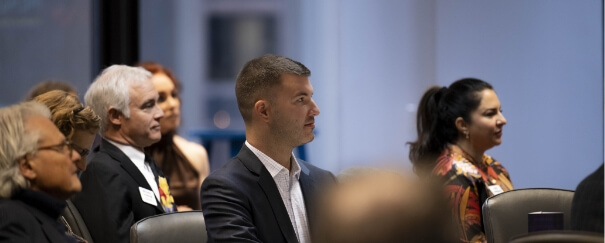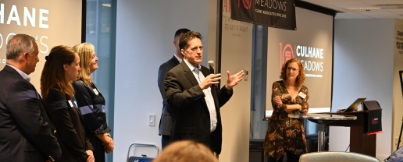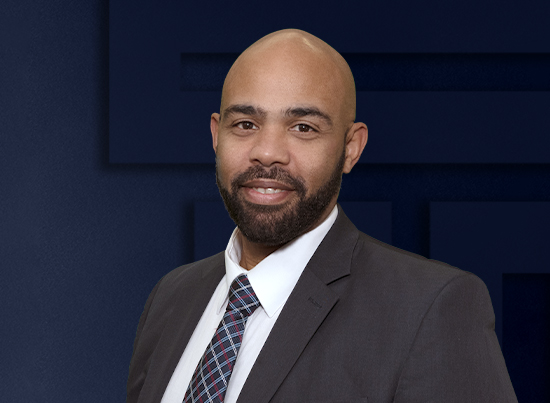Culhane Meadows’ Philadelphia partner Sekou Campbell recently authored an article published in Law360 which discusses how the film and television industry can expand its concept of diversity beyond representation.
This article is dangerous. It’s why Frances McDormand hyperventilated in the lead-up to saying two simple words, “inclusion rider,” at the end of her 2018 Academy Award acceptance speech.
It’s also why the late Sacheen Littlefeather was booed and ridiculed for highlighting the mistreatment of indigenous peoples in the film industry in her rejection speech after Marlon Brando’s Oscar win for best actor in 1973 — for which the Academy of Motion Picture Arts and Sciences apologized last year.
As the Oscars approach, and we celebrate the ever-growing landscape of filmmakers in the U.S. and around the world, there remains a nagging diversity issue in the industry that should be called out — as McDormand and Littlefeather did — and for which legal solutions exist.
Representation Matters, But …
Over the last few years, particularly since the murder of George Floyd in 2020, companies have spruced up policies around diversity, equity, belonging and inclusion.
For media companies, though, diversity should mean more than mere representation. It should include processes for mitigating harm, particularly in marginalized communities.
The Annenberg Inclusion Initiative, a think tank that studies diversity and inclusion in entertainment, notes that less than 2% of top-grossing film directors are women of color, 47% of the top-100 grossing films of 2016 did not feature a single Black woman or girl in a speaking on-screen role, 66% had no Asian female characters and 72% had no Latinas.[1]
The Annenberg Inclusion Initiative has produced powerful research illustrating the lack of representation in Hollywood films. While representation matters, does representation, by itself, actually diversify or, more importantly, provide equity, belonging and inclusion to marginalized communities?
A myopic and representation-only focus on diversity and inclusion can undermine rather than support critical diversity aims. For instance, the top-grossing film — in inflation- adjusted dollars, as of 2021 — “Gone With the Wind,” had Black women with speaking roles.[2] Nevertheless, HBO Max temporarily pulled the film from its streaming service because of its “painful stereotypes of people of color.”[3]
By contrast, in 1925, before “Gone With the Wind” was released, Alain Locke ushered in the Harlem Renaissance saying,
Whoever wishes to see the Negro in his essential traits, in the full perspective of his achievement and possibilities, must seek the enlightenment of that self-portraiture which the present developments of Negro culture are offering.[4]
The distinction between the “enlightenment of … self-portraiture” and the presentation of the enslaved character Mammy in “Gone With the Wind” illustrates how representation is a necessary but insufficient condition for diversity and inclusion.
While all of American society has made progress since 1939, the year “Gone With the Wind” was released, the industry continues to distribute a largely cisgender-white-male vision of the world.
Inclusion Riders
The Annenberg Inclusion Initiative also developed the inclusion rider that McDormand made famous, a useful agreement that calls for more members of underrepresented communities to participate in major film and television projects.
The inclusion rider is a great first step because it holds studios and networks accountable for hiring a cast and crew that reflects the rich tapestry of America’s population.
Similar concepts have been adopted in community benefits agreements, film tax credit programs and other diversity incentive programs whereby companies doing business in a particular municipality or state may enjoy greater benefits and lower costs by simply hiring more underrepresented workers on their projects.
New Jersey, for example, provides a 2% or 4% transferable tax credit for tracking and meeting certain diversity targets on film and television projects.
These efforts seem to have had an impact. The Writers Guild of America’s 2022 report on inclusion and equity finds that Black and indigenous people, people of color, and white women have made progress as a percentage of all writers.
However, the majority of decision makers — executive producers and showrunners — remain white men. That means that those who are contributing content to film and television projects, more often than not, have to answer to and get approval from white men.
Therefore, while some content that treats marginalized people with similar care and nuance as their overrepresented counterparts is produced, the story and vision for most projects remain in the hands of one small group.
As evidenced by the dozens of Academy Award categories, film as well as other media projects contain creative contributions from many areas like editing, sound design, music, cinematography, acting, costume, hair and makeup, and writing.
To facilitate the global distribution of such works, creative contributors often do not retain significant intellectual property rights in their contributions. Even when marginalized people are included via a rider or any other means, there remains a risk that the final version of their work misrepresents them or their community because those contributors lack control over their intellectual property.
Thus, while the industry works to extend inclusion and equity to its decision-making ranks, other interventions may help to address the biases that plague film and television. The inclusion rider can expand to account for ownership and decision making, rather than mere representation.
Waivers
With respect to documentary films and other nonfiction works, where name and likeness, privacy, and other personal rights are typically waived — and the producer released from any claims related thereto — producers must balance the need to foreclose the risks arising out of broad distribution of content with the risk of misrepresenting certain communities’ stories.
Some practitioners have provided for a tiered system of approvals or consents to ensure documentary subjects are candid but do not lose agency over the story told about them or their community.
For instance, producers may provide a release after, rather than before, an interview; allow a subject of a project to review a rough cut in order to decide whether to grant a waiver after viewing how they are portrayed; or bind themselves to certain limited uses of the interview requiring further consent for other uses.
These concepts bring the subjects of a nonfiction work more into the filmmaking process without sacrificing the filmmakers’ creative direction.
That said, careful consideration must be given to distribution of such projects because failure to procure sufficient waivers and releases may prevent it from certain opportunities for broad distribution based on requirements set forth by distributors, insurers and the like.
SPEs
The corporate form offers producers another remedy. Productions often use a special purpose entity that owns all of a project’s assets, including its intellectual property. The SPE, which is usually a limited liability company, allows media projects to streamline their accounting, financing, governance and risk management.
Typically, an SPE exchanges financing for an ownership stake in the entity, with a revenue distribution priority to the SPE’s financiers for the amount they have invested plus a premium. The concept behind such an arrangement is that a project cannot get made without a financial investment, and financiers should enjoy priority and a healthy return given the risks involved in producing and releasing a television or film project.
Because an SPE is typically an LLC, SPEs offer film and television producers creative and innovative ways to advance diversity and inclusion goals.
In an LLC, members and managers — or, the owners and decision makers — often have some significant decision making and financial interests in the company. SPEs can be structured in unique ways to allow important collaborators and contributors to aid in the creation of more equitable systems of ownership, decision making and financing.
For example, Zendaya, in the 2021 film “Malcolm & Marie,” came up with a way to provide a financial interest in the project to its crew.[5]
Many projects have set up a royalty pool to share financial benefits with contributors and that same approach can be used to expand decision making for projects. This concept exists in other industries.
Toyota Motor Corp., for instance, developed a well-regarded system that allowed anyone on its assembly line to identify problems and aid in the decision-making process for correcting such issues.[6]
SPEs can be structured to allow for similar decision-making protocols that help prevent the types of biases prevalent in popular films.
For instance, if a documentary filmmaker develops a project that focuses on the LGBTQ community, appointing a member of that community to serve as a manager for that SPE alongside other stakeholders in the film, rather than using them as a mere consultant, can help mitigate against problematic decisions concerning that community.
Coupling such appointments with reasonable dispute resolution processes that encourage communication and compromise may help mitigate any biases that exist when producing media projects.
To accommodate the SPE’s expanded governance, participants and the SPE’s counsel need to pay special attention to conflicts of interest. Typically, an investor in an SPE has separate counsel and thus these issues do not arise.
However, some contributors who participate in this type of SPE may not have the means or the network to retain competent counsel. Depending on the applicable state ethics rules, production counsel may need to explain the potential conflicts and obtain informed consent from contributors to waive those conflicts at the time the SPE is created.
These types of waivers are fairly common among the founders of a film entity to avoid the duplicative costs and largely aligned interests of those parties.
On the other hand, if an individual joins the SPE after formation, the conflict is more likely to be unwaivable, in which case that person would need separate counsel.
Conclusion
Clearly, the film and television industry has come a long way from Mammy. However, the field should continue to expand its concept of diversity beyond representation to include an assessment of the actual impact stories and characters have on the broader community.
If that analysis yields a conclusion that the project will have significant community impact, particularly on disempowered or marginalized communities, expanding the SPE infrastructure to include a more diverse slate of contributors and subjects of a particular project will help.
In sum, diversity means more than representation, and corporate law can hold the producers, networks and studios that facilitate the production of images and stories to reasonable accountability in their decision making among affected stakeholders.
Using the concepts presented here may help continue to advance the progress made in more equitable representation in film and television, while mitigating against the lack of representation among decision makers in the industry.
In addition to becoming better corporate citizens, investing in these kinds of concepts may yield a healthy return. According to a 2021 McKinsey & Co. report, by “addressing the persistent racial inequities, the industry could reap an additional $10 billion in annual revenues.”[7]
Sekou Campbell is a partner at Culhane Meadows Haughian & Walsh PLLC.
The opinions expressed are those of the author(s) and do not necessarily reflect the views of their employer, its clients, or Portfolio Media Inc., or any of its or their respective affiliates. This article is for general information purposes and is not intended to be and should not be taken as legal advice.
Download PDF of this article HERE
About Culhane Meadows – Big Law for the New Economy®
The largest woman-owned national full-service business law firm in the U.S., Culhane Meadows fields over 70 partners in eleven major markets across the country. Uniquely structured, the firm’s Disruptive Law® business model gives attorneys greater work-life flexibility while delivering outstanding, partner-level legal services to major corporations and emerging companies across industry sectors more efficiently and cost-effectively than conventional law firms. Clients enjoy exceptional and highly-efficient legal services provided exclusively by partner-level attorneys with significant experience and training from large law firms or in-house legal departments of respected corporations. U.S. News & World Report has named Culhane Meadows among the country’s “Best Law Firms” in its 2014 through 2023 rankings and many of the firm’s partners are regularly recognized in Chambers, Super Lawyers, Best Lawyers and Martindale-Hubbell Peer Reviews.
The foregoing content is for informational purposes only and should not be relied upon as legal advice. Federal, state, and local laws can change rapidly and, therefore, this content may become obsolete or outdated. Please consult with an attorney of your choice to ensure you obtain the most current and accurate counsel about your particular situation.









